Storm drain
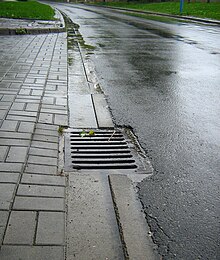
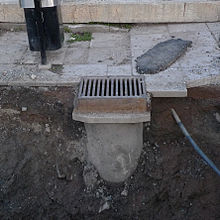
A storm drain, storm sewer (United Kingdom, U.S. and Canada), surface water drain/sewer (United Kingdom), or stormwater drain (Australia and New Zealand) is infrastructure designed to drain excess rain and ground water from impervious surfaces such as paved streets, car parks, parking lots, footpaths, sidewalks, and roofs. Storm drains vary in design from small residential dry wells to large municipal systems.

Drainage is the natural or artificial removal of a surface's water and sub-surface water from an area with excess water. The internal drainage of most agricultural soils can prevent severe waterlogging (anaerobic conditions that harm root growth), but many soils need artificial drainage to improve production or to manage water supplies.
Drains receive water from street gutters on most motorways, freeways and other busy roads, as well as towns in areas with heavy rainfall that leads to flooding, and coastal towns with regular storms. Even rain gutters from houses and buildings can connect to the storm drain. Since many storm drainage systems are gravity sewers that drain untreated storm water into rivers or streams, any hazardous substances poured into the drains will contaminate the destination bodies of water.
Storm drains sometimes cannot manage the quantity of rain that falls in heavy rains or storms. Inundated drains can cause basement and street flooding. Many areas require detention tanks inside a property that temporarily hold runoff in heavy rains and restrict outlet flow to the public sewer. This reduces the risk of overwhelming the public sewer. Some storm drains mix stormwater (rainwater) with sewage, either intentionally in the case of combined sewers, or unintentionally.
Nomenclature
[edit]Several related terms are used differently in American and British English.
| Term | American | British | Comments |
|---|---|---|---|
| Combined sewer | A sewer designed and intended to serve as a sanitary sewer and a storm sewer, or as an industrial sewer and a storm sewer[1]: 121 | Same as American English | Stormwater mixed with sewage |
| Storm sewer, Surface water sewer, or surface sewer | A sewer designed and intended to carry only stormwater, surface runoff, street wash waters, and drainage[1]: 668 | A sewer designed and intended to carry only rainwater runoff | Only stormwater |
| Stormwater bypass | Same as British English | A combined sewer discharge pipeline intended to bypass wastewater treatment plants during peak runoff events[citation needed] | Stormwater mixed with sewage |
| Road channel | See roadside ditch | A roadside channel to prevent uncontrolled runoff along roadway surfaces[citation needed] | Only stormwater |
| Road gully | See roadside ditch | Consists of a gully grating on a chamber that connects to a surface water sewer / drain, ditch, or watercourse | Only stormwater |
| Roadside ditch | A roadside channel to prevent uncontrolled runoff along roadway surfaces[2] | See road gully | Only stormwater |
Function
[edit]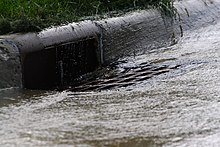
Inlet
[edit]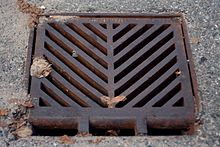
There are two main types of stormwater drain (highway drain or road gully in the UK) inlets: side inlets and grated inlets. Side inlets are located adjacent to the curb and rely on the ability of the opening under the back stone or lintel to capture flow. They are usually depressed at the invert of the channel to improve capture capacity.[3]
Many inlets have gratings or grids to prevent people, vehicles, large objects or debris from falling into the storm drain. Grate bars are spaced so that the flow of water is not impeded, but sediment and many small objects can also fall through. However, if grate bars are too far apart, the openings may present a risk to pedestrians, bicyclists, and others in the vicinity. Grates with long narrow slots parallel to traffic flow are of particular concern to cyclists, as the front tire of a bicycle may become stuck, causing the cyclist to go over the handlebars or lose control and fall. Storm drains in streets and parking areas must be strong enough to support the weight of vehicles, and are often made of cast iron or reinforced concrete.[citation needed]
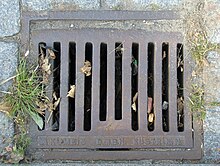
Some of the heavier sediment and small objects may settle in a catch basin, or sump, which lies immediately below the outlet, where water from the top of the catch basin reservoir overflows into the sewer proper. The catchbasin serves much the same function as the "trap" in household wastewater plumbing in trapping objects.
In the United States, unlike the plumbing trap, the catch basin does not necessarily prevent sewer gases such as hydrogen sulfide and methane from escaping. However, in the United Kingdom, where they are called gully pots,[4] they are designed as true water-filled traps and do block the egress of gases and rodents.
Most catchbasins contain stagnant water during drier parts of the year and can, in warm countries, become mosquito breeding grounds. Larvicides or disruptive larval hormones, sometimes released from "mosquito biscuits", have been used to control mosquito breeding in catch basins. Mosquitoes may be physically prevented from reaching the standing water or migrating into the sewer proper by the use of an "inverted cone filter". Another method of mosquito control is to spread a thin layer of oil on the surface of stagnant water, interfering with the breathing tubes of mosquito larvae.
The performance of catch basins at removing sediment and other pollutants depends on the design of the catchbasin (for example, the size of the sump), and on routine maintenance to retain the storage available in the sump to capture sediment. Municipalities typically have large vacuum trucks that perform this task.
Catch basins act as the first-line pretreatment for other treatment practices, such as retention basins, by capturing large sediments and street litter from urban runoff before it enters the storm drainage pipes.
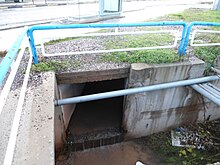
Piping
[edit]Pipes can come in many different cross-sectional shapes (rectangular, square, bread-loaf-shaped, oval, inverted pear-shaped, egg shaped, and most commonly, circular). Drainage systems may have many different features including waterfalls, stairways, balconies and pits for catching rubbish, sometimes called Gross Pollutant Traps (GPTs). Pipes made of different materials can also be used, such as brick, concrete, high-density polyethylene or galvanized steel. Fibre reinforced plastic is being used more commonly for drain pipes and fittings.[5]
Outlet
[edit]Most drains have a single large exit at their point of discharge (often covered by a grating) into a canal, river, lake, reservoir, sea or ocean. Other than catchbasins, typically there are no treatment facilities in the piping system. Small storm drains may discharge into individual dry wells. Storm drains may be interconnected using slotted pipe, to make a larger dry well system. Storm drains may discharge into human-made excavations known as recharge basins or retention ponds.
Environmental impacts
[edit]Water quantity
[edit]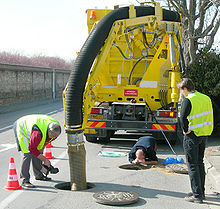
Storm drains are often unable to manage the quantity of rain that falls during heavy rains and/or storms. When storm drains are inundated, basement and street flooding can occur. Unlike catastrophic flooding events, this type of urban flooding occurs in built-up areas where human-made drainage systems are prevalent. Urban flooding is the primary cause of sewer backups and basement flooding, which can affect properties repeatedly.[6]
Clogged drains also contribute to flooding by the obstruction of storm drains. Communities or cities can help reduce this by cleaning leaves from the storm drains to stop ponding or flooding into yards.[7] Snow in the winter can also clog drains when there is an unusual amount of rain in the winter and snow is plowed atop storm drains.[8]
Runoff into storm sewers can be minimized by including sustainable urban drainage systems (UK term) or low impact development or green infrastructure practices (US terms) into municipal plans. To reduce stormwater from rooftops, flows from eaves troughs (rain gutters and downspouts) may be infiltrated into adjacent soil, rather than discharged into the storm sewer system. Storm water runoff from paved surfaces can be directed to unlined ditches (sometimes called swales or bioswales) before flowing into the storm sewers, again to allow the runoff to soak into the ground. Permeable paving materials can be used in building sidewalks, driveways and in some cases, parking lots, to infiltrate a portion of the stormwater volume.[9]
Many areas require that properties have detention tanks that temporarily hold rainwater runoff, and restrict the outlet flow to the public sewer. This lessens the risk of overburdening the public sewer during heavy rain. An overflow outlet may also connect higher on the outlet side of the detention tank. This overflow prevents the detention tank from completely filling. Restricting water flow and temporarily holding the water in a detention tank public this way makes it far less likely for rain to overwhelm the sewers.[10]
Water quality
[edit]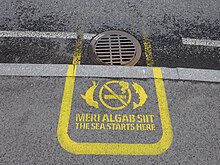
The first flush from urban runoff can be extremely dirty. Storm water may become contaminated while running down the road or other impervious surface, or from lawn chemical run-off, before entering the drain.
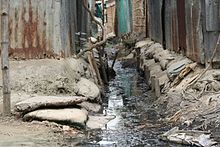
Water running off these impervious surfaces tends to pick up gasoline, motor oil, heavy metals, trash and other pollutants from roadways and parking lots, as well as fertilizers and pesticides from lawns. Roads and parking lots are major sources of nickel, copper, zinc, cadmium, lead and polycyclic aromatic hydrocarbons (PAHs), which are created as combustion byproducts of gasoline and other fossil fuels. Roof runoff contributes high levels of synthetic organic compounds and zinc (from galvanized gutters). Fertilizer use on residential lawns, parks and golf courses is a significant source of nitrates and phosphorus.[11][12]
Separation of undesired runoff can be achieved by installing devices within the storm sewer system. These devices are relatively new and can only be installed with new development or during major upgrades. They are referred to as oil-grit separators (OGS) or oil-sediment separators (OSS). They consist of a specialized manhole chamber, and use the water flow and/or gravity to separate oil and grit.[13]
Mosquito breeding
[edit]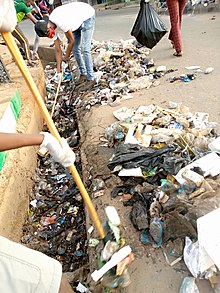
Catch basins are commonly designed with a sump area below the outlet pipe level—a reservoir for water and debris that helps prevent the pipe from clogging. Unless constructed with permeable bottoms to let water infiltrate into underlying soil, this subterranean basin can become a mosquito breeding area, because it is cool, dark, and retains stagnant water for a long time. Combined with standard grates, which have holes large enough for mosquitoes to enter and leave the basin, this is a major problem in mosquito control.[15]
Basins can be filled with concrete up to the pipe level to prevent this reservoir from forming. Without proper maintenance, the functionality of the basin is questionable, as these catch basins are most commonly not cleaned annually as is needed to make them perform as designed. The trapping of debris serves no purpose because once filled they operate as if no basins were present, but continue to allow a shallow area of water retention for the breeding of mosquito. Moreover, even if cleaned and maintained, the water reservoir remains filled, accommodating the breeding of mosquitoes.
Relationship to sanitary sewer systems
[edit]
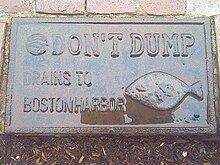
Storm drains are separate and distinct from sanitary sewer systems. The separation of storm sewers from sanitary sewers helps prevent sewage treatment plants becoming overwhelmed by infiltration/inflow during a rainstorm, which could discharge untreated sewage into the environment.
Many storm drainage systems drain untreated storm water into rivers or streams. In the US, many local governments conduct public awareness campaigns about this, lest people dump waste into the storm drain system.[16] In Cleveland, Ohio, for example, all new catch basins installed have inscriptions on them not to dump any waste, and usually include a fish imprint as well. Trout Unlimited Canada recommends that a yellow fish symbol be painted next to existing storm drains.[17]
Combined sewers
[edit]Cities that installed their sewage collection systems before the 1930s typically used single piping systems to transport both urban runoff and sewage. This type of collection system is referred to as a combined sewer system (CSS). The cities' rationale when combined sewers were built was that it would be cheaper to build just a single system.[18] In these systems a sudden large rainfall that exceeds sewage treatment capacity is allowed to overflow directly from storm drains into receiving waters via structures called combined sewer overflows.[19]
Storm drains are typically installed at shallower depths than combined sewers. This is because combined sewers were designed to accept sewage flows from buildings with basements, in addition to receiving surface runoff from streets.[20]
About 860 communities in the US have combined sewer systems, serving about 40 million people.[21] New York City, Washington, D.C., Seattle and other cities with combined systems have this problem due to a large influx of storm water after every heavy rain event. Some cities have dealt with this by adding large storage tanks or ponds to hold the water until it can be treated. Chicago has a system of tunnels, collectively called the Deep Tunnel, underneath the city for storing its stormwater.[22] Many areas require detention tanks or roof detention systems that temporarily hold runoff in heavy rains and restrict outlet flow to the public sewer. This lessens the risk of overwhelming the public sewer in heavy rain. An overflow outlet may also connect higher on the outlet side of the detention tank. This overflow prevents the detention tank from completely filling. By restricting the flow of water in this way and temporarily holding the water in a detention vault or tank or by rooftop detention, public sewers are less likely to overflow.[23]
Regulations and local building codes
[edit]Building codes and local government ordinances vary greatly on the handling of storm drain runoff. New developments might be required to construct their own storm drain processing capacity for returning the runoff to the water table and bioswales may be required in sensitive ecological areas to protect the watershed.
In the United States, cities, suburban communities and towns with over 100,000 population, smaller community drainage systems in urbanized areas and additional municipal systems that are specifically designated by state agencies are required to obtain discharge permits for their storm sewer systems, under the Clean Water Act.[24] The Environmental Protection Agency (EPA) issued stormwater regulations for large cities in 1990 and for other communities in 1999.[25] The permits require local governments to operate stormwater management programs, covering both construction of new buildings and facilities, and maintenance of their existing municipal drainage networks. For new construction projects, many municipalities require builders to obtain approval of the site drainage system along with the structural plans. State government facilities, such as roads and highways, are also subject to the stormwater management regulations.[26]
Examples
[edit]Southeastern Los Angeles County installed thousands of stainless steel, full-capture trash devices on their road drains in 2011.[27]
Exploration
[edit]An international subculture has grown up around the exploration of stormwater drains. Societies such as the Cave Clan regularly explore the drains underneath cities. This is commonly known as "urban exploration", but is also known as draining when in specific relation to storm drains.[28]
Residence
[edit]In several large American cities, homeless people live in storm drains. At least 300 people live in the 200 miles of underground storm drains of Las Vegas, many of them making a living finding unclaimed winnings in the gambling machines.[29] An organization called Shine a Light was founded in 2009 to help the drain residents after over 20 drowning deaths occurred in the preceding years.[29][30] A man in San Diego was evicted from a storm drain after living there for nine months in 1986.[31]
Current practices
[edit]Geotextiles
[edit]New storm water drainage systems incorporate geotextile filters that retain and prevent fine grains of soil from passing into and clogging the drain. Geotextiles are synthetic textile fabrics specially manufactured for civil and environmental engineering applications. Geotextiles are designed to retain fine soil particles while allowing water to pass through. In a typical drainage system, they would be laid along a trench which would then be filled with coarse granular material: gravel, sea shells, stone or rock. The geotextile is then folded over the top of the stone and the trench is then covered by soil. Groundwater seeps through the geotextile and flows through the stone to an outfell. In high groundwater conditions a perforated plastic (PVC or PE) pipe is laid along the base of the drain to increase the volume of water transported in the drain.
Alternatively, a prefabricated plastic drainage system made of HDPE, often incorporating geotextile, coco fiber or rag filters can be considered. The use of these materials has become increasingly more common due to their ease of use, since they eliminate the need for transporting and laying stone drainage aggregate, which is invariably more expensive than a synthetic drain and concrete liners.
Over the past 30 years, geotextile, PVC filters, and HDPE filters have become the most commonly used soil filter media. They are cheap to produce and easy to lay, with factory controlled properties that ensure long term filtration performance even in fine silty soil conditions.
21st century alternatives
[edit]Seattle's Public Utilities created a pilot program called Street Edge Alternatives Project. The project focuses on designing a system "to provide drainage that more closely mimics the natural landscape prior to development than traditional piped systems".[32] The streets are characterized by ditches along the side of the roadway, with plantings designed throughout the area. An emphasis on non-curbed sidewalks allows water to flow more freely into the areas of permeable surface on the side of the streets. Because of the plantings, the run off water from the urban area does not all directly go into the ground, but can also be absorbed into the surrounding environment. Monitoring conducted by Seattle Public Utilities reports a 99 percent reduction of storm water leaving the drainage project.[32]
Drainage has undergone a large-scale environmental review in the recent past[when?] in the United Kingdom. Sustainable urban drainage systems (SUDS) are designed to encourage contractors to install drainage system that more closely mimic the natural flow of water in nature. Since 2010 local and neighbourhood planning in the UK is required by law to factor SUDS into any development projects that they are responsible for.
Slot drainage is a channel drainage system designed to eliminate the need for further pipework systems to be installed in parallel to the drainage, reducing the environmental impact of production as well as improving water collection. Stainless steel, concrete channel, PVC and HDPE are all materials available for slot drainage which have become industry standards on construction projects.
In the construction industry
[edit]The civil engineer is responsible for drainage in construction projects. During the construction process, they set out all the necessary levels for roads, street gutters, drainage, culverts and sewers involved in construction operations.
Civil engineers and construction managers work alongside architects and supervisors, planners, quantity surveyors, and the general workforce, as well as subcontractors. Typically, most jurisdictions have some body of drainage law to govern to what degree a landowner can alter the drainage from their parcel.
Drainage options for the construction industry include:
- Point drainage, which intercepts water at gullies (points). Gullies connect to drainage pipes beneath the ground surface, so deep excavation is required to facilitate this system. Support for deep trenches is required in the shape of planking, strutting or shoring.
- Channel drainage, which intercepts water along the entire run of the channel. Channel drainage is typically manufactured from concrete, steel, polymer or composites. The interception rate of channel drainage is greater than point drainage and the excavation required is usually much less deep.
The surface opening of channel drainage usually comes in the form of gratings (polymer, plastic, steel or iron) or a single slot (slot drain) that run along the ground surface (typically manufactured from steel or iron).
In retaining walls
[edit]Earth retaining structures such as retaining walls also need to have groundwater drainage considered during their construction. Typical retaining walls are constructed of impermeable material, which can block the path of groundwater. When groundwater flow is obstructed, hydrostatic water pressure buildups against the wall and may cause significant damage. If the water pressure is not drained appropriately, retaining walls can bow, move, and fracture, causing seams to separate. The water pressure can also erode soil particles, leading to voids behind the wall and sinkholes in the above soil. Traditional retaining wall drainage systems can include French drains, drain pipes or weep holes. To prevent soil erosion, geotextile filter fabrics are installed with the drainage system.
In planters
[edit]Drainage in planters refers to the implementation of effective drainage systems specifically designed for plant containers or pots. Proper drainage is crucial in planters to prevent waterlogging and promote healthy plant growth. Planter Drainage involves the incorporation of drainage holes, drainage layers, or specialized drainage systems to ensure excess water can escape from the planter. This helps to prevent root rot, water accumulation, and other issues that can negatively impact plant health. By providing adequate drainage in planters, it supports optimal plant growth and contributes to the overall success of gardening or landscaping projects.[33]
Drainage options for the planter include:
- Surface drains are typically used to manage runoff from paved surfaces, such as sidewalks and parking lots. Catch basins, which collect water and debris, are connected to underground pipes that carry the water away from the site.[33]
- Subsurface drains, on the other hand, are designed to manage water that seeps into the soil beneath the planting surface. French drains, which are gravel-filled trenches with perforated pipes at the bottom, are the most common type of subsurface drain. Trench drains, which are similar but shallower and wider, are also used in some situations.[33]
Reasons for artificial drainage
[edit]
Wetland soils may need drainage to be used for agriculture. In the northern United States and Europe, glaciation created numerous small lakes which gradually filled with humus to make marshes. Some of these were drained using open ditches and trenches to make mucklands, which are primarily used for high value crops such as vegetables.
The largest project of this type in the world has been in process for centuries in the Netherlands. The area between Amsterdam, Haarlem and Leiden was, in prehistoric times, swampland and small lakes. Turf cutting (peat mining), subsidence and shoreline erosion gradually caused the formation of one large lake, the Haarlemmermeer, or lake of Haarlem. The invention of wind-powered pumping engines in the 15th century permitted drainage of some of the marginal land, but the final drainage of the lake had to await the design of large, steam powered pumps and agreements between regional authorities. The elimination of the lake occurred between 1849 and 1852, creating thousands of km2 of new land.
Coastal plains and river deltas may have seasonally or permanently high water tables and must have drainage improvements if they are to be used for agriculture. An example is the flatwoods citrus-growing region of Florida, United States. After periods of high rainfall, drainage pumps are employed to prevent damage to the citrus groves from overly wet soils. Rice production requires complete control of water, as fields need to be flooded or drained at different stages of the crop cycle. The Netherlands has also led the way in this type of drainage, not only to drain lowland along the shore, but actually pushing back the sea until the original nation has been greatly enlarged.
In moist climates, soils may be adequate for cropping with the exception that they become waterlogged for brief periods each year, from snow melt or from heavy rains. Soils that are predominantly clay will pass water very slowly downward, meanwhile plant roots suffocate because the excessive water around the roots eliminates air movement through the soil.
Other soils may have an impervious layer of mineralized soil, called a hardpan or relatively impervious rock layers may underlie shallow soils. Drainage is especially important in tree fruit production. Soils that are otherwise excellent may be waterlogged for a week of the year, which is sufficient to kill fruit trees and cost the productivity of the land until replacements can be established. In each of these cases appropriate drainage carries off temporary flushes of water to prevent damage to annual or perennial crops.
Drier areas are often farmed by irrigation, and one would not consider drainage necessary. However, irrigation water always contains minerals and salts, which can be concentrated to toxic levels by evapotranspiration. Irrigated land may need periodic flushes with excessive irrigation water and drainage to control soil salinity.
History
[edit]Archaeological studies have revealed use of rather sophisticated stormwater runoff systems in ancient cultures. For example, in Minoan Crete around 2000 BC, cities such as Phaistos were designed to have storm drains and channels to collect precipitation runoff. At Cretan Knossos, storm drains include stone-lined structures large enough for a person to crawl through.[34] Other examples of early civilizations with elements of stormwater drain systems include early people of Mainland Orkney such as Gurness and the Brough of Birsay in Scotland.
Early history
[edit]
The Indus Valley Civilization had sewerage and drainage systems. All houses in the major cities of Harappa and Mohenjo-daro had access to water and drainage facilities. Waste water was directed to covered gravity sewers, which lined the major streets.[35]
18th and 19th century
[edit]
The invention of hollow-pipe drainage is credited to Sir Hugh Dalrymple, who died in 1753.[36]
Gallery
[edit]-
A storm drain discharging into the River Brent in the UK
-
Iron Cove Creek, Sydney, Australia
-
Storm drain in Obertraun, Austria
-
Storm drain overflowing in Durham, North Carolina
-
114" pipe installation; Pipe: 114" aluminized type 2; Flow: 25 cubic meters/second; This is a storm drain in Guasave, Mexico.
-
Inside the Markeaton Interceptor Storm Relief Culvert
-
Old storm drain in Kutná Hora, the Czech Republic
See also
[edit]References
[edit]- ^ a b King, James J. (1995). The environmental dictionary and regulatory cross reference (3rd ed.). New York: Wiley. ISBN 0-471-11995-4.
- ^ Amimoto, Perry Y. (1981). Erosion and Sediment Control Handbook. State of California. p. 109.
- ^ Kerb Inlet, Local Government & Municipal Knowledge Base, accessed February 6, 2010,
- ^ Field, Richard and Daniel Sullivan.Wet-Weather Flow in the Urban Watershed: Technology and Management, p. 109, at Google Books
- ^ "Fiberglass Pipe Past, Present and Future". Fiberglass Tank & Pipe. Retrieved 3 February 2022.
- ^ "The Prevalence and Cost of Urban Flooding" (PDF). Center for Neighborhood Technology. May 2013. Retrieved 12 October 2021.
- ^ "Wet Weather Preparation Tips". Seattle, WA: Seattle Public Utilities. Retrieved 2024-05-13.
- ^ Nelson, Tim. "Mpls. preps for possible flooding on Christmas". Retrieved 2017-08-26.
- ^ Brattebo, B. O.; Booth, D. B. (2003). "Long-Term Stormwater Quantity and Quality Performance of Permeable Pavement Systems" (PDF). Water Research. 37 (18): 4369–4376. Bibcode:2003WatRe..37.4369B. doi:10.1016/S0043-1354(03)00410-X. PMID 14511707. Archived from the original (PDF) on 2007-03-27.
- ^ "Reinforced concrete | Definition, Properties, Advantages, & Facts | Britannica". www.britannica.com. Retrieved 2023-04-21.
- ^ Water Environment Federation, Alexandria, VA; and American Society of Civil Engineers, Reston, VA. "Urban Runoff Quality Management." WEF Manual of Practice No. 23; ASCE Manual and Report on Engineering Practice No. 87. 1998. ISBN 1-57278-039-8. Chapter 1.
- ^ Burton, G. Allen Jr.; Pitt, Robert (2001). Stormwater Effects Handbook: A Toolbox for Watershed Managers, Scientists, and Engineers. New York: CRC/Lewis Publishers. ISBN 0-87371-924-7. Archived from the original on 2009-05-19. Retrieved 2009-06-03. Chapter 2.
- ^ Shoemaker, Leslie; Lahlou, Mohammed; Doll, Amy; Cazenas, Patricia (2002). "Fact Sheet--Oil/Grit Separator Units". Stormwater Best Management Practices in an Ultra-Urban Setting: Selection and Monitoring. Washington, DC: U.S. Federal Highway Administration. Archived from the original on 2011-10-15. Retrieved 2011-11-16.
- ^ "Plastic bags clogging Bangkok's sewers complicate efforts to fight floods". The Straits Times. SPH Media Ltd. 2016-09-06.
- ^ Clinical Medicine & Research February 1, 2005 vol. 3 no. 1 3-12.
- ^ "NPS Outreach Toolbox: General Stormwater and Storm Drain Awareness". Polluted Runoff. Washington, D.C.: U.S. Environmental Protection Agency (EPA). 2017-03-22.
- ^ Trout Unlimited, Calgary, AB. "How does Yellow Fish Road Work?" Archived 2009-07-17 at the Wayback Machine Accessed 2011-11-16.
- ^ Burrian, Steven J.; et al. (1999). The Historical Development of Wet-Weather Flow Management (Report). Cincinnati, OH: EPA National Risk Management Research Laboratory. EPA 600/JA-99/275.
- ^ EPA. "Combined Sewer Overflow (CSO) Control Policy." Federal Register, 59 FR 18688. April 19, 1994.
- ^ Metcalf & Eddy, Inc. (1972). Wastewater Engineering. New York: McGraw-Hill. p. 119.
- ^ "Combined Sewer Overflow Frequent Questions". National Pollutant Discharge Elimination System. EPA. 2023-06-01.
- ^ "Chicago digs deep to better manage stormwater". American City and County. London: Informa PLC. 1996-06-01.
- ^ "Combined Sewer Overflow". New York: Water Watch NYC. 2009-12-22.
- ^ United States. Water Quality Act of 1987. Pub. L. 100–4 Approved 1987-02-04. Sec. 402(p),
- ^ "Stormwater Discharges from Municipal Sources". EPA. 2024-05-08.
- ^ Woelkers, David A. (September–October 2002). "Tidal Wave: Stormwater Ordinances as a BMP for Phase II". Stormwater. Forester Media. Archived from the original on 2011-07-16.
- ^ Barboza, Tony (November 1, 2011). "Tons of L.A. River trash will be captured before it hits the sea". L.A. NOW Southern California -- this just in. Los Angeles Times. Retrieved May 18, 2021.
- ^ "Garrett, 2012, UE Magazine, Issue Three | PDF". Scribd. Retrieved 2023-03-16.
- ^ a b Adams, Guy (14 September 2009). "Subterranean home of Las Vegas's losers". The Independent. Archived from the original on 2022-05-25. Retrieved 21 May 2010.
- ^ O'Brien, Matt (2007). Beneath the Neon: Life and Death in the Tunnels of Las Vegas. Huntington Press. ISBN 978-0-929712-39-0.
- ^ Associated Press (17 April 1986). "Sewer loser". Beaver County Times. Retrieved 21 May 2010.
- ^ a b "Street Edge Alternatives (SEA Streets) Project". Seattle.gov. Archived from the original on Dec 5, 2008.
- ^ a b c "4 Expert Tips for Perfect Planter Drainage". drainservice.org. 15 April 2023. Archived from the original on June 30, 2023. Retrieved July 1, 2023.
- ^ C. Michael Hogan (2007). "Knossos fieldnotes." Modern Antiquarian.
- ^ Arthur Coterell (1980). The Encyclopedia of Ancient Civilisations. Rainbird Publishers. pp. 176–178. ISBN 0-7112-0036-X.
- ^ "Broadside eulogy dedicated to Patrick, Earl of Marchmount, Sir Hugh Dalrymple, and others". National Library of Scotland Digital Gallery. 1705. Retrieved 5 April 2015.
External links
[edit]- EPA – Combined Sewer Overflows Archived 2014-07-14 at the Wayback Machine
- EPA Storm Drain Stenciling Took Kit
- 7 Steps to Clean Water from Great Lakes Green Initiative (example of a local public awareness program)










